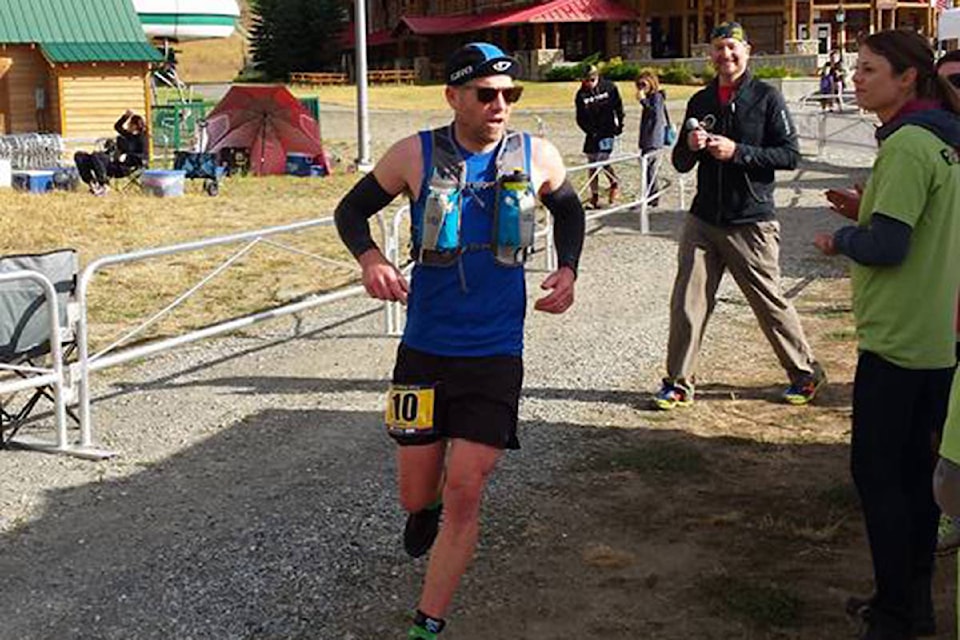The Black Spur Ultra race, presented by Sinister Sports, is coming back to Kimberley for the sixth time on August 21 to 22, 2021. The race has runs of 54 and 108 kilometres, done solo or in relays.
Paddy Humenny of Kimberley has been involved with the Black Spur since its inception, from three different perspectives: a participant, a volunteer and a sponsor.
He had already been running ultras — generally speaking any race over a marathon distance of 42.195 kilometres — for a while before Bryan Gallant, owner of Sinister Sports, chose Kimberley as the home for the Black Spur, so Humenny got on board very early.
READ MORE: The Black Spur Ultra
Before running ultras, Humenny was an ultra endurance mountain biker, up until about 2012, when he started crewing for friends who were getting into endurance running. He quickly fell in love with the scene and in 2013 trained for an 80 miler called the Canadian Death Race. The first Black Spur wasn’t too long after that and it’s just snowballed from there.
He explained that he enjoys running and found he was quite good at it. As a self employed man who owns an outdoor supply store, he loves getting out into the backcountry but doesn’t always have the necessary time to do so. Endurance running has become a way that he can get out and do an excursion in a single day that would take an average backpacker three or four.
Humenny agreed that these ultra races are certainly not for everyone, but the Black Spur offers a few ways for people interested in pushing themselves to get into ultra racing without doing the full 108 km solo run.
The Black Spur in particular thrives on participants who join up as relay teams, allowing the runners to attack a stretch and then rest while their teammate takes over.
Asked to described what motivates someone to put their bodies and minds through something as intense as an Ultra, Humenny had many thoughts.
“Ultras are kind of like life in a day,” he said. “You’re going to go through bad spells, you’re going to go through great highs, you’re going to see people that are struggling, you might struggle yourself and there’s going to be perseverance within that too.”
While running up and down a mountain, over rocks and roots, pushing yourself to the very limit, Humenny said you go through the entire gamut of human emotion and while the course is long, the biggest distance in a 54 or 108 kilometre race is the “six inches between your ears.”
“There’s going to be highs and lows,” he said. “People talk about runner high, like in a marathon where you get to that point where everything feels effortless, your mind is zen because you’re just focused on one task, you’re just out there running.
“Trail running is the same way. When you’re out in the mountains if you’re in a good mindset and you’re staying hydrated and on top of your nutrition, generally your mind is in a happy place, it’s when you start getting tired, maybe a little dehydrated, maybe a little fatigued that the brain worms as we call it work their way in.”
He said that while ultras don’t necessarily attract one specific type of person, competitors are likely very strong willed, strong in the mind, a little stubborn and perhaps a little quirky.
There are some who are extremely competitive and want to set the best time for the rest of the group, there are others for whom it is a purely personal battle. Humenny, for example, said he tends to be more on the competitive side, but what blows him away are those who “close out the course.”
“They’re chasing time limits, they’re chasing the cutoffs, they’re out there the longest, they’re ultimately going the slowest but they’re also going through all of those experiences.”
Intentions going in are important, Humenny said. If you’re in it to try and impress other people, you’re probably doing it for the wrong reasons, and you’re more likely to struggle than succeed.
“That struggle isn’t necessarily defined by a result, you could be first place and not necessarily be strong mentally and you could be last and come out of it so well that the rest of your life is changed because you’ve realized you can really do anything that you put your mind to.”
Following the race, it’s easy to tell who’s participated. Look for those who appear extremely fit, but are walking like they’ve aged 40 or 50 years. Humenny said that after an effort like that your body takes a day or two to come down from the experience, and it’s usually accompanied by swollen muscles, sore bones, blisters and chaffing.
After the comedown from the runners high, almost like an addiction, there’s a period of crash, and then you’re left thinking “what’s next.”
paul.rodgers@kimberleybulletin
Like us on Facebook and follow us on Twitter



